After the Earth's Violent Sway: Tangible and intangible legacies of a natural disaster


Overview
This three-year project aims to document and analyse the cultural and political impacts of Nepal’s 2015 earthquakes. The physical impact of a natural disaster such as a major earthquake is immediately visible: lost lives, displaced people, destroyed houses and a shattered cultural heritage. However, the longer-term impact and legacy of such an event is less apparent.
The project, which began on 1 April 2017, is structured along three distinct but inter-related themes.
First, it investigates the post-earthquake cultural and political discourse in Nepal. Nepal emerged from a ten-year civil war in 2006, and the country’s main political players then embarked upon the long process of transition from a monarchical Hindu state to a democratic federal republic. The 2015 earthquakes had a major impact upon this process. The project explores the ways in which they influenced the ongoing political, media and literary discourse on a number of key cultural, social and political issues.
Second, the project asks who it is that decides which elements of an aid-dependent country’s destroyed physical heritage are worth restoring. It investigates the extent to which the selection and prioritisation of sites and buildings for restoration is driven by what is held locally to be most ‘dear’, and to what extent by the evaluations of external donors and heritage experts.
Third, the project draws historical comparisons between the sociocultural and political impacts of the 2015 quakes and those of the major quakes that struck Nepal during earlier periods of political and cultural transition in 1833 and 1934. Archives in London, Delhi and Kathmandu are being explored for contemporaneous documentation.
Impact
This project will contribute substantially to understandings of the longterm sociopolitical and cultural impacts of natural disasters, especially in aid-dependent low-income countries where the state is weak. It will deliver impact in a range of contexts.
Our work will be of considerable interest to Governmental departments and international agencies engaged in delivering relief and development aid to countries in the global South, including Nepal.
Our analysis of the ways in which national and international actors relate to one another in decision-making processes and policy making related to the protection, documentation and reconstruction of Nepal's physical cultural heritage will be of interest to international organisations as well as local institutions and projects.
The project will fill a significant gap in the public understanding of the aftermath of the Nepal earthquake, to the alleviation of whose effects the British and international public contributed with such generosity.
Finally, the project will contribute to Nepali public understandings of the tumultuous series of events that followed in the wake of the disaster.
The electronic resources assembled and produced by this project will be preserved over the long term in the SOAS Digital Library’s SWAY database of research materials. By the end of the project, all material except restricted file layers and copyright protected material will be made publicly accessible online.
"After the Earth's Violent Sway" is funded by the Global Challenges Research Fund through the Arts and Humanities Research Council (AHRC).
Team
- Principal Investigator: Michael Hutt, SOAS University of London
- Co-Investigator: Stefanie Lotter, SOAS University of London
- Co-Investigator: Mark Liechty, University of Illinois at Chicago
- Researcher: Jeevan Baniya, Social Science Baha, Kathmandu
- Researcher: Yogesh Raj, Martin Chautari, Kathmandu (until 2018)
- Researcher: John Whelpton, independent researcher, Hong Kong
- Researcher: Seira Tamang, Independent Researcher Kathmandu
- Website and database content manager: Khem Shreesh, Social Science Baha, Kathmandu
- Digital Librarian: Erich Kesse, SOAS University of London
Further information




